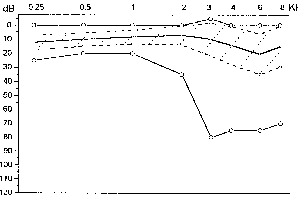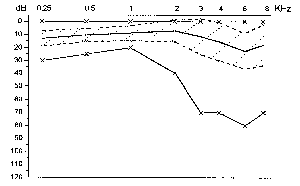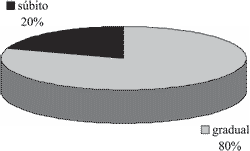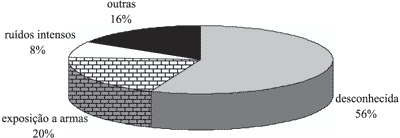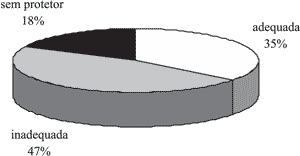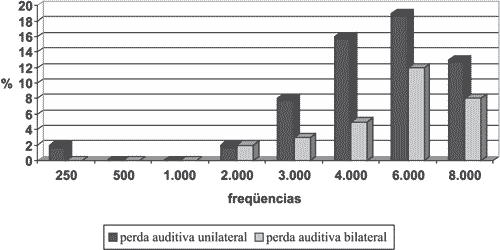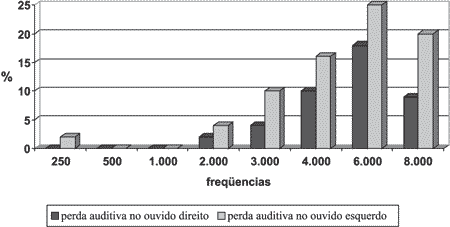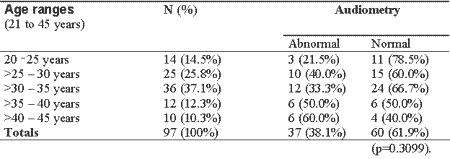

Year: 2004 Vol. 70 Ed. 3 - (9º)
Artigo Original
Pages: 344 to 350
Audiometric assessment of military personnel in Brazilian barracks
Author(s):
Ana P. Silva 1,
Everardo A. da Costa 2,
Salete M. M. Rodrigues 3,
Humberto L. R. Souza 4,
Valéria G. Massafera 5
Keywords: acoustic trauma, noise-induced hearing loss, military, firearms
Abstract:
The individuals rendering the military service are often liable to frequent noise in factories and discharge sounds deriving from firearms and detonations. These sort of undesirable sounds cause lesions the auditory system, which are sometimes irreversible, besides provoking bad effects to the body as a whole. Aim: Evaluating the auditory profiles from a specific group of military personnel, and according to the achieved results to promote the incentive towards the implantation of preventive measures related to auditory losses, such as auditory preservation programs. Study design: Transversal cohort. Material and Method: Auditory evaluation of 97 individuals working in a military organization, which included interviews, as well as otoscopic and audiometric tests. Results: From the total examined personnel, 38,1% presented audiometric changes supposedly noise-induced since these changes prevailed in the artillerymen, being the unilateral hearing loss predominant. The use of no proper protection equipment was observed in 64,5% of the total examined military personnel. Conclusion: The high level of hearing loss occurrences found between the military personnel joined to the absence of proper protection equipment for the exposition to noises, indicate the need of implanting prevention measures to avoid hearing losses among theses professionals.
![]()
INTRODUCTION
High intensity impulse noises caused by explosions are the most common cause for militaries to look for medical help in the United States, as well as in other countries 1. In Brazil, epidemiological studies on hearing disorders caused by high intensity impulse noise in military people are scarce.
A considerable percentage of the industrialized population suffers from auditory problems, being that high intensity impulse noise is responsible for a significant amount of permanent hearing losses 2.
Impact noise or impulse noise is understood as the noise that has acoustic energy peaks that last below 1 (one) second, at intervals higher than 1 (one) second 3. Impact noise can be classified as simple or repetitive. Simple impact noise is triggered by handling materials, hammers and also by firearm shooting; repetitive impact noise is produced by automatic printing machines, guillotines or pneumatic machinery, gun firing in consecutive shootings or even repetitive shooting 4 (NR15).
According to Plontke et al.2, impact noise can be defined as short sound noise with duration of about 0.2ms that is usually produced by quick gas expansion, such as in firearms and bomb explosions. These sounds can reach intensity and frequency of about 140dB SPL and 2 to 3 kHz, respectively, and can for this reason, be harmful to human ear.
The effects of impact noise can be innocuous, such as a round of applause, or dangerous, such as explosions. They can damage the hearing system, with mechanical ruptures or inner ear sensorial portion's affections 1.
Impact not resulting from explosions can cause temporary or permanent physiological or anatomical changes to the cochlea, leading to auditory disorders characterized by changes in thresholds, difficulties in speech perception and tinnitus 2.
As human ear is exposed to impulse noise whose intensity is about 120dB or higher, there is acoustic trauma. Sound load will produce severe lesions in the cochlea, such as rupture of basilar membrane, disorganization of tissues and hair cells, in an abrupt fashion. Clinically, there is immediate and permanent sensorineural hearing loss, uni or bilateral, with presence of constant tinnitus. In some cases, the auditory loss can present improvement for some days, recovering social hearing in many occasions 5.
In explosions, there may be simultaneous damage to the middle ear, such as tympanic membrane rupture, disarticulation of ossicles or vestibular system damage. If there is impairment of middle ear, the mechanism of natural protection of Corti's organ gets into action. In these cases, inner ear impairment is less marked 6.
As to firearm use, acoustic energy is usually impulse noise, with high peaks of sound pressure, between 160 and 190 dB, according to Temmel et al.7. The sudden increase in acoustic pressure results in immediate and severe auditory sequel (profound hearing loss), as well as tinnitus. Many acoustic trauma cases occur in soldiers and naval industry workers.
According to Stewart et al.8, in the United States, gunfire explosion is the main cause of noise-induced hearing loss. As a result of increase in shooting as sport, a larger number of people suffer acoustic trauma or gradual sensorineural loss secondary to excessive noise caused by firearm. Sudden hearing loss results from high sound pressure level of impulse noise that exceeds critical level, which can cause mechanical or metabolic damage to inner ear structures. Gradual hearing loss is the result of exposure during many years to impulse noise of firearms that are not sufficiently loud to cause acoustic trauma, but cause harmful effects to inner ear structures in the long run. Some patients come to the service of audiology owing to difficulty in understanding speech and others owing to tinnitus.
In Brazil, Godoy (1991)4 conducted an auditory assessment study in the Formation of Army Military Course through interviews and audiometric assessment of participants at the beginning and at the end of the course. The author detected changes to hearing in a significant number of students (24%) within a period of 20 months. These changes occurred predominantly among those exposed to noise levels higher than 80dB.
Seballos (1995)9 conducted a study about assessment of auditory conditions in subjects exposed to noise from firearms caliber 12. Average sound intensity to which subjects were exposed was 125.7 dB. They detected that the occurrence of auditory affections caused by acoustic trauma in subjects exposed to noise of firearms was greater when exposure time to noise was higher than 10 years and in subjects with advanced age. In the audiometric exam, they detected significant changes in frequencies of 4 to 8kHz.
Neves-Pinto et al. (1997)10 published their observations about acoustic traumas among 60 artillerymen and they found 23 cases of typical acoustic trauma. The same authors conducted many different studies with airplane crew and found significant affections to hearing of studied subjects.
Brito (1998)11 conducted a study of auditory assessment of civil and military flying crew of the Air Force to detect early hearing losses. The subjects were submitted to conventional audiometric tests and high frequency audiometry (12Kz). The results showed changes to frequencies of 12,000Hz in subjects that were considered normal in the conventional exam, allowing early detection of cochlear problems by noise exposure.
Bandeira (1979)12 conducted a study of auditory assessment in 54 military men that worked for security services, conducting weekly shooting exercises. He detected high incidence of sensorineural hearing loss (63.4%), out of which 30.7% had typical curves of acoustic trauma.
The Brazilian Legislation of occupational safety and medicine, Regulating Norm No. 15 (1978) defined tolerance limits to continuous or intermittent and impact noise, respectively. In Annex II we defined the tolerance limits for impact noise. They provide severe and immediate risk of exposure, without protection, to levels of impact higher than 140dB (linear), measures of circuit for impact responses, or higher than 130dB (C), measured in the fast circuit response (FAST) 3.
The present study aimed at assessing the auditory profile of a group of military personnel in the Army and, in view of the results, we intended to encourage the implementation of preventive measures of hearing loss, such as auditory conservation program.
MATERIAL AND METHOD
It was a clinical transversal study approved by the National Ethics Research Center (CONEP).
We studied 97 subjects that worked in a military institution of the Army, all male subjects of varied ages exposed to loud sound pressure level environment.
The mean age was 31.91 years, ranging from 21 to 45 years. Considering distribution by time in service, on average it was 12.75 years, ranging from 2 to 32 years. As to jobs, we divided them into three groups: artillery, administrative and support (it included military areas of communication, healthcare, maintenance and food).
Auditory assessments consisted of interview, ENT examinations and audiometry tests. In the interview, we studied: current hearing, otological background, current and previous diseases, surgical and traumatic affections, use of ototoxic medications, exposure to previous occupation and extra-occupational noise, use of weapons, in addition to personal data.
We conducted basic otological examination and audiometric assessment comprising pure tone thresholds, speech reception threshold (SRT) and impedanciometry, being that all subjects had had noise rest for 14 hours. We used acoustically treated booth (Vibrasom VSA40), audiometer (Siemens SD25) and impedanciometer (Dicton ZA44).
Figure 1. Graph of audiometry of military personnel, right ear. Continuous lines represent mean, minimum, maximum values and dotted lines are standard deviation.
Figure 2. Graph of audiometry of military personnel, left ear. Continuous lines represent mean, minimum, maximum values and dotted lines are standard deviation.
Graph 1. Reported onset of hearing loss (n=25).
Graph 2. Reported causes to explain hearing loss (n=25).
Graph 3. Exposure to extra-occupational noise (n=97).
Graph 4. Correlation between hearing protection used in shooting exercises.
Graph 5. Correlation of uni or bilateral hearing loss frequency (N=37).
Graph 6. Correlation of hearing loss on the right or left ear (N=37).
RESULTS
Out of 97 studied military men, 61.9% presented audiometric characteristics within acceptable levels (thresholds equal or greater than 25dB in all frequencies, according to Administrative Rule 19, Labor and Employment Minister Office) (NR 17) 13 and 38.1% had abnormal audiometric configurations, most of them suggestive of noise-induced hearing loss (Figures 1 and 2).
As to age range distribution, subjects aged 40 to 45 years presented the highest percentage (60%) of affected audiometric tests, and the trend was that the older the age, the higher the number of abnormal audiometric tests (Table 1).
As to time in service, the largest group of 15 years in service presented the highest potential (41.6%) of abnormal audiometry, and the tendency was the longer the time in service, the higher the number of abnormal audiometry (Table 2).
As to functions of each subject, the ones that presented the most affected audiometry (42.9%) were in artillery (Table 3).
As to current hearing status reported in the interview, 74.2% reported that their current hearing was good, whereas 25.8% reported medium range reduction. Among the subjects that reported good hearing status, 30.5% presented abnormal audiometry (Table 4).
Out of those that reported average hearing loss, 80% reported that the hearing loss had had gradual onset (Graph 1) and 56% did not relate hearing loss and some apparent cause (Graph 2).
The most frequently reported symptoms in the interview were irritation with loud sounds and temporary hearing loss, among others listed in Table 5.
We also investigated extra-occupational hearing loss, being that the most frequently reported habits were: going to discos, watching live music shows, and making activities with noisy machinery (Graph 3).
As to current job in the military organization, 33.7% reported that they were exposed to loud noise, being that they all participated in shooting exercises with different types of guns, as listed in Table 6.
A percentage of 82.3% of them used some type of auditory protection during noise exposure to firearm, but only 35.4% made use of the appropriate protection, such as earphones and plugs, 46.8% make use of the wrong protection (cotton), and 17.7% do not use auditory protection (Table 7 and Graph 4).
As to unilateral hearing loss, we found higher percentage in high frequencies, being that the most affected frequency was 6kHz, in 19.5% of the cases (Table 8 and Graph 5). As to the most affected ear, the left side presented more affections in frequencies higher than 2KHz (Table 9 and Graph 6).Table 1. Distribution by age range and abnormal audiometric findings versus those within acceptable limits.
Table 2. Distribution by time in service and abnormal audiometric findings versus those within acceptable limits.
Table 3. Distribution by job and abnormal audiometric findings versus those within normal range.
Table 4. Correlation between normal hearing and abnormal audiometry.
Table 5. Relation of symptoms reported in the interview.
Table 6. Relation of type of arms and exposure to impact noise.
DISCUSSION
Cox & Ford14 confirmed that 20 to 30% of the militaries have some hearing loss caused by exposure to firearm noise. In the present study we found 38.14% of hearing loss in the studied subjects.
The most affected age range was 40 to 45 years and the trend was that the older the age, the higher the number of abnormal audiometric tests. These results are in accordance with the study by Seballos 9, which detected that occurrence of auditory affection caused by acoustic trauma in subjects exposed to noise caused by firearm was greater in older subjects.
As to distribution by time in service, subjects with over 15 years exposure presented the highest percentage of abnormal audiometric tests and the tendency was that the longer the time in service, the greater the number of affected tests, in agreement with what was found by Cox & Ford14, in which subjects with over 15 years in the military service the percentage of hearing loss was over 50%. In the studies by Axelsson & Hamernik15 the maximum hearing loss was reached within five years of military service, as well as in the study by Alvarez16, which showed hearing disorders occurred when duration of exposure was higher than six years.
As to subjects' jobs, the most affected group was that of artillery, probably because they were exposed directly in the shooting exercise field to weapons and howitzer, either not protected or inappropriately protected. In the study by Alvarez16 about incidence of acoustic trauma in units of tanks and artillery, the most affected group was that of artillerymen, probably attributed to lack of appropriate hearing protection.
Out of interviewed subjects that reported good hearing, one third presented abnormal audiometry, which is probably due to the fact that most hearing losses were in high frequencies. Alvarez16 explained that hearing loss was not much manifested by the studied subjects, since the affected frequencies were 4 to 8kHz.
Out of those that reported average hearing reduction, 40% presented audiometry within the normal range. Among them only 20% reported that hearing loss was of sudden onset, reporting exposure to firearm or loud noise. Most reported that hearing loss had gradual onset, not related to any specific cause. According to the study presented by Stewart et al.8, most of the patients exposed to excessive noise of firearms suffered acoustic trauma or gradual sensorineural hearing loss.
Most of the subjects (56%) did not know the cause of hearing loss and did not relate it to any apparent cause.
The most frequent complaint in the present sample was irritation with loud noises, followed by temporary hearing loss after loud noise. In the study by Alvarez16, the most frequent symptoms were excessive tiredness, headache and tinnitus; in the study by Stewart et al.8, the patients went to the service of audiology owing to difficulties to understand speech or because of tinnitus. Tinnitus is the most common symptom found in many other studies, being that in the present study it was reported in only 16.49% of the subjects. According to Mrena et al.17, tinnitus and hearing loss are the most common symptoms reported after exposure to noise that causes acoustic trauma. Tinnitus can disappear after some time or persist for a long period, affecting people's quality of life 17.
Currently, it is known that many types of high intensity noise are capable of causing hearing loss. For this reason, extra-occupational exposure was investigated, being that about one third of the subjects reported that they used to go to discos, attend live musical shows and work with noisy machinery without any type of auditory protection.
As to types of weapons, over 90% of the interviewed subjects were exposed to impact noise by light automatic rifle and 9mm gun and one third was exposed to howitzer noise.
Even though they were aware of the fact that continuous and high intensity impact noise causes irreversible lesions to the inner ear and that prevention results from auditory protection, most of the investigated subjects were not properly protected: 17.71% did not use any type of protection and 46.88% used only cotton balls as hearing protection. Konopka et al.18 studied 10 soldiers aged 20 years exposed to impact noise of automatic firearms without hearing protection and they detected hearing disorders in these subjects. Temmel et al.7 conducted a study about acoustic trauma caused by impact noise in military privates; 80% of them reported that they were not using protection when the acoustic trauma happened.
In the present study the most affected frequencies in the audiometric tests were 4 to 8kHz, the same ones found by Seballos9 and Alvarez16. In the study by Temmel et al.7 about acoustic trauma, the analysis of the audiometric curve revealed that 75% of the hearing loss cases affected frequencies higher than 2kHz7.
In our study there was predominance of unilateral hearing loss over bilateral ones, being that we found a higher percentage of high frequency losses. Temmel et al.7 conducted a study about acoustic trauma and detected predominance of unilateral hearing loss (80.2%) over bilateral ones (13.6%).
Concerning the affected ear, the left ear presented greater percentage in relation to the right ear in frequencies higher than 2kHz. In the study by Alvarez16, the left ear was also the most affected in artillerymen. The author believed that the lesion depended on the ear that was closer to the sound source (given the positions that each one holds the gun in combat situations).
The authors observed that the interviewed subjects did not have any information about auditory risks caused by impact noise of the arsenal used, nor the way in which they could protect themselves and prevent hearing loss. For this reason, it is critical to implement preventive measures in military units.
CONCLUSION
1. Out of 97 militaries included in the study and exposed to loud noise from gunshot exercises, 38.1% presented otological manifestations suggestive of noise-induced hearing loss;
2. Only 25.8% of the subjects had hearing loss complaints and among those without complaints, 30.5% had some characteristic audiometric configuration;
3. Hearing loss was more severe the older and the longer the time in service;
4. The main complaints observed were irritation with loud sounds (54.6%) and temporary hearing loss (40.2%). The patients that complained of tinnitus were only 16.4%;
5. Out of all examined subjects, 64.59% did not make use of the right protection during shooting exercises;
6. This professional category requires more information and preventive measures for occupational hearing loss.
ACKNOWLEDGEMENT
The authors would like to acknowledge the Commander of the military organization for having authorized the use of the institution for the study and to all military participants that took part in this study for their availability and collaboration.
REFERENCES
1. Patterson Jr JH, Johnson DL. Protection of hearing against high-intensity impulse noise. J Acoust Soc Am 1996; 99(1):23.
2. Plontke SKR, Pfeffer C, Zenner HP, Dietz K. The incidence of acoustic trauma due to New Year's firecrackers. Eur Arch Otorhinlaryngol 2002; 259(5):247-52.
3. Brasil. Portaria nº 3214. Ministério do Trabalho 08/07/1978/ NR15. Atividades e operações insalubres (D.O.U. 06/07/1978).
4. Godoy TCM. Perdas auditivas induzidas pelo ruído em militares: um enfoque preventivo; 1991.Tese de mestrado, PUC, São Paulo; 1991;1-136.
5. Bento RF, Miniti A, Marone SAM. Tratado de otologia. São Paulo, Editora USP: 1998; 274-82.
6. Hungria H. Trauma sonoro. Otorrinolaringologia. 7ª ed, Rio de Janeiro: Ed. Guanabara Koogan: 1995; 389-92.
7. Temmel AFP, Kierner AC, Steurer M, Riedl S, Innitzer J. Hearing loss and tinnitus in acute acoustic trauma. Wien Klin Wochenschr 1999; 111(21):891-3.
8. Stewart M, Pankiw R, Lehman ME, Simpson TH. Hearing loss and hearing handicap in users of recreational firearms. J Am Acad Audiol 2002; 13(3):160-8.
9. Seballos SL. Condição auditiva de praticantes com arma de fogo; 1995. Tese de mestrado, Universidade Federal de Santa Maria, Rio Grande do Sul; 1995. p.1-64.
10. Neves-Pinto RMN, Monteiro ARC, Selimam J. Perda auditiva induzida pelo ruído: revisão das Publicações por Brasileiros no período 1938-1970. In: Nudelman AA, Costa EA, Seligman J, Ibañez RN. PAIR - Perda auditiva Induzida pelo Ruído, Porto Alegre: Bagaggem Comunicação, 1997; 33-9.
11. Brito NAL Limiares auditivos na freqüência de 12.000 Hz em Aeronavegantes. Rev méd Aeronaut Bras 1998; 48(1/2):65-7.
12. Bandeira FAS, Fróes HC, Hercos Jr C. Trauma acústico. Rev Bras Otorrinol 1979; 45:261-6.
13. Brasil. Portaria nº 19. Secretaria Segurança e Saúde no Trabalho 09/04/1998/ NR7. Programa de Controle médico de Saúde ocupacional. Anexo1. Diretrizes e parâmetros mínimos para avaliação e acompanhamento da audição em trabalhadores expostos a níveis de pressão sonora elevado. (D.O.U. 22/04/1998).
14. Cox HJ, Ford GR. Hearing loss associated with weapons noise exposure: when to investigate an asymmetrical loss. J Laryngol Otol 1995; 109:291-5.
15. Axelsson A, Hamernik RP. Acute acoustic trauma. Acta Otolaryngol 1987; 104:225-33.
16. Santana Alvarez J. Estúdio del trauma acústico em unidades de tanques y artilleria. Arch med Camagüey 1998; 2(3):6-12.
17. Mrena R, Savolainen S, Kuokkanen JT, Ylikoski J. Characteristics of tinnitus induced by acute acoustic trauma: a long-term follow-up. Audiol Neurootol 2002; 7(2):122-30.
18. Konopka W, Pietkiewicz P, Zalewski P. Otoacoustic emissions examinations in soldiers before and after shooting. Otolaryngol Pol 2002; 54(6):745-9.
1 Otorhinolaryngology, Intern, Ambulatory of Occupational Otorhinolaryngology, special participant, Post-graduation in Collective Healthcare, Medical School - FCM, Unicamp.
2 Ph.D., Collaborating Professor, Discipline of Otorhinolaryngology, Head and Neck Surgery, Post-Graduation Program in Collective Healthcare, FCM, Unicamp.
3 Joint Professor, Department of Otorhinolaryngology, Hospital das Clinicas, Medical School, Pouso Alegre/ MG.
4 Military Physician, 1st Lieutenant, Artillery Group, Brazilian Army.
5 Speech and hearing therapist.
Address correspondence to: Ana Paula da Silva - Rua Duque de Caxias, 957 Centro Santa Bárbara d' Oeste SP 13450-000
Tel (55 19) 3463-6073 - Fax: (55 19) 3455-0101 - E-mail: anasbo@bol.com.br
Study presented at 3º Congresso Triológico de Otorrinolaringologia, Rio de Janeiro/RJ, October 8 - 11, 2003.
Affiliation: Discipline of Otorhinolaryngology, Head and Neck Surgery, Medical School, Unicamp/SP.
